
Byzantine architecture is the architecture of the Byzantine Empire, or Eastern Roman Empire.

Neo-Byzantine architecture was a revival movement, most frequently seen in religious, institutional and public buildings. It incorporates elements of the Byzantine style associated with Eastern and Orthodox Christian architecture dating from the 5th through 11th centuries, notably that of Constantinople and the Exarchate of Ravenna.

The Church of Saint George is a Late Antique red brick rotunda in Sofia, Bulgaria. Built in the early 4th century as Roman baths, it became a church inside the walls of Serdica, capital of ancient Dacia Mediterranea during the Roman Empire and Byzantine Empire. The Early Christian church is considered the oldest building in modern Sofia and belongs to the Bulgarian Orthodox Church.

The Saint Sofia Church is the oldest church in the Bulgarian capital Sofia, dating to the fourth century. In the predecessor building took place the Council of Serdica held most probably in 343 and attended by 316 bishops. In the 14th century, the church gave its name to the city, previously known as Serdika (Сердика).
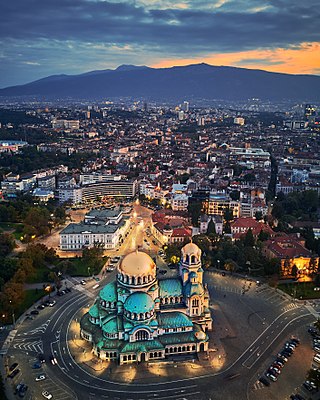
St. Alexander Nevsky Cathedral is a Bulgarian Orthodox cathedral in Sofia, the capital of Bulgaria. Built in Neo-Byzantine style, it serves as the cathedral church of the Patriarch of Bulgaria and it is one of the 50 largest Christian church buildings by volume in the world. It is one of Sofia's symbols and primary tourist attractions. St. Alexander Nevsky Cathedral in Sofia occupies an area of 3,170 square metres (34,100 sq ft) and can hold 5,000 people inside. It is among the 10 largest Eastern Orthodox church buildings. It is the largest cathedral in the Balkans. It is believed that up until the year 2000 it was the largest finished Orthodox cathedral.

The Holy Forty Martyrs Church is a medieval Eastern Orthodox church constructed in 1230 in the town of Veliko Tarnovo in Bulgaria, the former capital of the Second Bulgarian Empire.

The Monument to the Tsar Liberator is an equestrian monument in the centre of Sofia, the capital of Bulgaria. It was erected in honour of Russian Emperor Alexander II who liberated Bulgaria from Ottoman rule during the Russo-Turkish War of 1877-78.

The Dormition of the Mother of God Cathedral is the largest church building in Varna and the third largest cathedral in Bulgaria. Officially opened on 30 August 1886. It is the residence of the bishopric of Varna and Preslav and one of the symbols of Varna.

Sveta Nedelya Cathedral Church, is an Eastern Orthodox cathedral in Sofia, the capital of Bulgaria, a cathedral of the Sofia bishopric of the Bulgarian Patriarchate. The temple of Sveta Nedelya dates back to the 10th century, being a cathedral of the city from the 18th century. The sacred building has suffered destruction through the ages and has been reconstructed many times. The present building of the temple is among the landmarks of Sofia. It was designed by the famous Bulgarian architectural team Vasilyov-Tsolov. The relics of the Serbian king Stefan Uroš II Milutin are kept in the church.
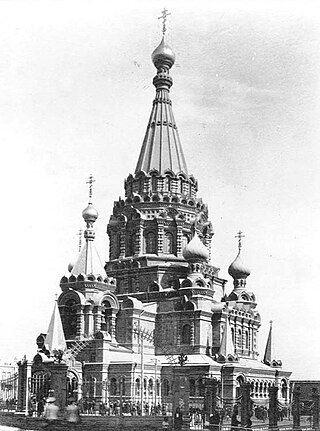
The Alexander Nevsky Cathedral was the main Russian Orthodox cathedral in Baku, Azerbaijan from when it was completed in 1898 until its destruction in 1937 during the Soviet era under Joseph Stalin. The cathedral was the biggest Russian Orthodox structure ever built in the South Caucasus.

The Sveti Sedmochislenitsi Church and formerly The Black Mosque is a Bulgarian Orthodox church in Sofia, the capital of Bulgaria. It was created between 1901 and 1902 as an Ottoman mosque later converted into orthodox Church, and was inaugurated on 27 July 1903. The church is named after Cyril and Methodius and their five disciples, known in the Orthodox Church collectively as the Sedmochislenitsi.

The painting of the Tarnovo Artistic School was the mainstream of the Bulgarian fine arts between 13th and 14th centuries named after the capital and the main cultural center of the Second Bulgarian Empire, Tarnovo.
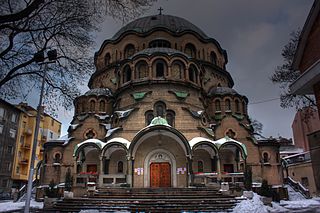
The Church of St Paraskeva is a Bulgarian Orthodox church in Sofia, the capital of Bulgaria. The church, dedicated to Saint Paraskeva, is located on 58 Georgi Rakovski Street in the centre of the city. It is the third-largest church in Sofia.

The Red Church is a large partially preserved late Roman Christian basilica in south central Bulgaria. Dating to the late 5th–early 6th century, the church stands near the town of Perushtitsa in western Plovdiv Province, some 15 kilometres (9.3 mi) southwest of the city of Plovdiv. The Red Church is a rare example of solid brick construction in a church from Late Antiquity in Bulgaria, and it was the red colour of the bricks that gave the church its name.
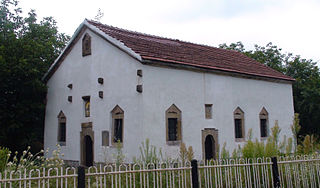
Saint George's Church is a church in Gavril Genovo, a village in northwestern Bulgaria, part of Georgi Damyanovo municipality, Montana Province. It was built in 1873 by the architect Alekso Angelkov of the Slavine Architectural School in the village of Sotochino, today one of the two neighbourhoods of Gavril Genovo. The church, otherwise a minor village parish church, is notable for its use of vernacular Gothic Revival features, a trademark approach of that school which set it apart from other architectural schools of the Bulgarian National Revival.
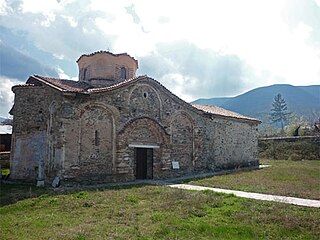
The Church of St Demetrius is a medieval Eastern Orthodox church in southwestern Bulgaria. It lies in the village of Patalenitsa, administratively part of Pazardzhik Municipality within Pazardzhik Province. The church was built in the 11th–14th century, with a possible dating to 1091 based on a stone plate inscription, the present location or even existence of which is unclear. Its frescoes, discovered in 1961 and restored in the 1970s, are a work of the 12th–13th century.

The Church of St George is a medieval Eastern Orthodox church in the city of Kyustendil, which lies in southwestern Bulgaria and is the administrative capital of Kyustendil Province. The church is located in the Kolusha neighbourhood, which was historically separate from the city. The church was constructed in the 10th–11th century and its frescoes are somewhat later, as the earliest layers were painted in the 11th–12th century.

The Church of St Nicholas is a partially preserved medieval Eastern Orthodox church in the town of Melnik in Blagoevgrad Province, southwestern Bulgaria. Dating to the late 12th century, it stands on top of an ancient Thracian sanctuary and a 5th-century basilica. In the Middle Ages, the church served as the cathedral of Melnik's bishop. The interior of the church features frescoes of rarely depicted scenes, as well as a 13th-century inscription. Its bell tower used to house one of the oldest extant church bells in Europe, discovered by archaeologists in the 2000s.

The Church of St John the Baptist, also known as the Church of St John the Precursor or, locally, Sveti Yani or Sveti Yan, is a small medieval Eastern Orthodox church in the town of Asenovgrad in Plovdiv Province, south central Bulgaria. The church is located on a cliff west of the town and dates to the 12th–
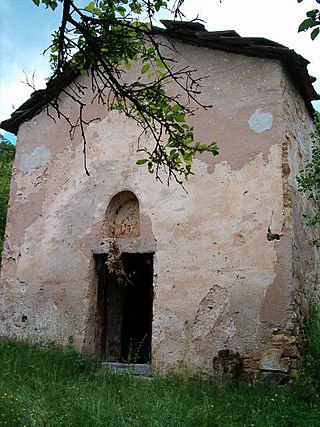
The Church of St Peter or Church of Saints Peter and Paul is a small medieval Bulgarian Orthodox church located in the village of Berende in Dragoman Municipality, Sofia Province, in westernmost Bulgaria. Most likely constructed and decorated in the 14th century, the Church of St Peter features simple stone architecture but contains a number of remarkable interior frescoes.




















